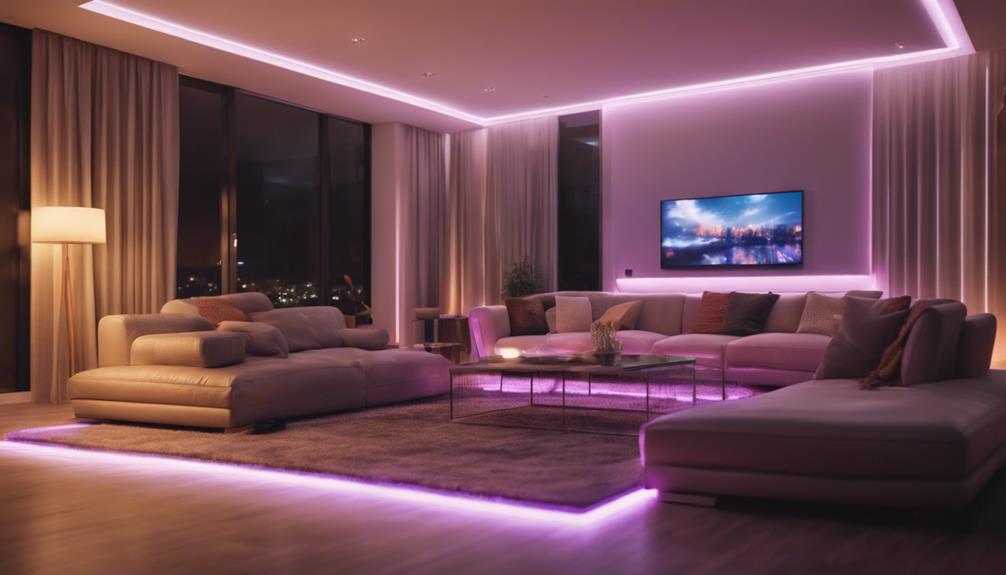LED lighting is known for its cost-effectiveness, saving 80-90% energy and lasting up to 30 times longer than incandescent bulbs. It promotes environmental sustainability with 100% recyclability and a reduction in carbon footprint by up to one third. LED lights’ efficiency of 80-90% and longevity of 30,000-50,000 hours emphasize their energy efficiency. They enhance safety with bright illumination, improve security, and offer versatile applications due to their directional output. Additionally, the blue light emitted can enhance mood and productivity. Learn more about these beneficial aspects of LED lighting.
Key Takeaways
- Cost-efficient with up to 90% energy savings.
- Environmentally sustainable and 100% recyclable.
- Remarkable energy efficiency, consuming 75% less energy.
- Longevity and durability, lasting up to 30 times longer.
- Enhances safety, security, and well-being with bright, uniform, and mood-boosting lighting.
Cost-Efficient Lighting Solution
Switching to LED lighting provides a highly cost-efficient solution due to its remarkable energy-saving capabilities and long-lasting performance. LED lighting can save up to 80-90% more energy compared to traditional lighting options, resulting in substantial reductions in energy costs. Additionally, LED bulbs can last up to 30 times longer than incandescent bulbs, reducing replacement costs and overall maintenance expenses.
The operational lifetime of LED lighting can reach up to 100,000 hours, greatly reducing the need for frequent replacements and maintenance. This extended lifespan contributes to cost savings and enhances operational efficiency. LED lights offer a durable lighting solution that not only saves on energy costs but also minimizes maintenance costs over time.
Environmental Sustainability

LED lighting plays an essential role in promoting environmental sustainability through its recyclability and reduced carbon footprint, making it a greener choice for lighting solutions. LED lights are 100% recyclable, greatly reducing the carbon footprint by up to a third compared to traditional lighting options. By opting for LED lights, individuals can save the materials and production required for 25 incandescent bulbs, showcasing the efficiency and eco-friendly nature of LED technology.
Unlike fluorescent bulbs that contain toxic chemicals like mercury, LED lights are free of such harmful substances, making them a safer and more sustainable lighting option. Choosing LED lights not only supports a greener future but also encourages sustainable practices that benefit the environment. LED lighting plays an important role in contributing to a cleaner planet by being environmentally friendly, aligning with the global push towards more sustainable and eco-conscious technologies.
Longevity and Durability

LED lighting offers exceptional longevity and durability compared to traditional lighting options. LED bulbs can last up to 30 times longer than incandescent bulbs, with an impressive lifespan of 30,000-50,000 hours, making them a reliable and long-lasting choice for various settings.
Their resistance to damage from shock, vibrations, and impacts enhances their durability, ensuring they can withstand rugged conditions with ease.
Extended Lifespan Benefits
With an operational lifespan ranging from 30,000 to 50,000 hours, LED bulbs offer unparalleled longevity and durability compared to traditional incandescent options. LED lights are known for their extended lifespan, reducing maintenance costs and providing energy savings.
Unlike incandescent bulbs that burn out, quality LEDs dim gradually over time, ensuring consistent illumination throughout their lifespan. Additionally, LEDs are breakage-resistant and can withstand vibrations, making them durable in various conditions.
The instant-on feature of LEDs allows them to reach full brightness immediately without any delay, enhancing their convenience and practicality. These factors contribute to the overall longevity and durability of LED lighting, making them a reliable and cost-effective choice for consumers.
Strong and Reliable
Demonstrating exceptional durability and longevity, LED lighting surpasses traditional options in reliability and performance. LED bulbs boast long life spans, lasting 3-5 times longer than CFL bulbs and up to 30 times longer than incandescent bulbs.
With an expected lifespan of 30,000-50,000 hours, LEDs provide consistent illumination over years, making them highly reliable. Unlike traditional bulbs that burn out, LEDs dim gradually, ensuring high performance throughout their lifespan.
Additionally, LED lights are breakage resistant and can withstand vibrations and impacts, enhancing their durability in various environments. Their durability and longevity translate to low maintenance costs, making them a cost-effective lighting solution compared to traditional options.
LED lighting emerges as an energy-efficient, durable, reliable, and high-performance choice for a wide range of applications.
Resistant to Damage
Extremely resilient to various forms of damage, LED lights exhibit exceptional longevity and durability in operation, setting them apart from traditional lighting options.
LED lights are highly durable, resistant to shock, vibrations, and impacts, ensuring long-lasting performance. Unlike traditional bulbs that burn out, LED lights gradually emit lower light levels over time, extending their operational lifespan.
Their rugged components make them perfect for outdoor use in rough conditions and harsh weather, ideal for areas prone to vandalism or extreme weather exposure. Additionally, LED lights don't use glass enclosures, enhancing their durability and making them immune to breakage compared to traditional lighting options.
This resilience to damage contributes to the reliability and longevity of LED lighting solutions.
Enhanced Energy Efficiency

Achieving remarkable energy efficiency levels, LED lighting stands out for its ability to convert a substantial portion of electrical energy directly into light. With an impressive efficiency range of 80-90%, LEDs only lose about 20% of the energy as heat, making them far superior to traditional lighting options that operate at a mere 20% efficiency. This significant difference translates to notable energy savings and reduced electricity costs for consumers.
Residential LED lights, for instance, consume at least 75% less energy than incandescent bulbs, contributing to a more sustainable and eco-friendly living environment. The shift towards LED technology is projected to continue growing, with the majority of lighting installations in the US expected to be LED-based by 2035. This transformation could potentially save up to 569 terawatt-hours (TWh) of energy annually, showcasing the immense impact of LED lighting in reducing wasted energy and promoting energy efficiency.
Improved Safety and Security

LED lighting not only excels in energy efficiency but also greatly enhances safety and security through its advanced features. By providing bright and uniform illumination, LED lights reduce the risk of accidents and injuries in indoor and outdoor spaces. Dark spots and shadows in parking lots and walkways are eliminated, ensuring better visibility for individuals.
Additionally, LED lighting aids in security efforts by enhancing surveillance camera footage with high color rendering capabilities, allowing for clearer images and improved visibility. The incorporation of motion sensors in LED lights further bolsters security measures by detecting movement and activating lighting in dimly lit areas.
In emergency situations, LED lights play an important role in illuminating emergency exits and signage, facilitating swift and safe evacuations. The combination of these features makes LED lighting a reliable choice for enhancing safety and security in various settings, from residential areas to commercial spaces.
Design Versatility

With its adaptability and range of customizable features, LED lighting presents a myriad of design possibilities for various settings. LED lights offer different color temperatures, ranging from warm white to cool white, allowing users to create environments that suit diverse moods and preferences. The customizable dimming capabilities of LED fixtures provide flexibility in adjusting light levels, enabling the creation of different atmospheres and enhancing visual comfort.
The design versatility of LED lighting is further enhanced by the availability of RGB LEDs, which enable dynamic color-changing effects. This makes them ideal for decorative and accent lighting applications, adding vibrancy and style to any space. Additionally, the directional nature of LED light output allows for precise lighting control, ensuring that light is focused exactly where it's needed. This feature enhances both the aesthetic appeal and functionality of LED lighting designs in residential, commercial, and other settings.
Health and Well-Being Benefits

The importance of LED lighting extends beyond design possibilities to positively impact the health and well-being of occupants. LED lighting, by mimicking natural daylight, plays a vital role in enhancing mood and overall well-being. Studies have shown that exposure to natural light from LEDs can help reduce feelings of anxiety, depression, and even work-related injuries. Additionally, the directional lighting provided by LEDs aids in preventing eye strain and promotes better physical and mental health among individuals.
LED solutions are particularly beneficial for buildings lacking access to natural light sources, providing effective illumination that contributes to the occupants' well-being. Moreover, the blue light emitted by LEDs can enhance alertness and engagement, ultimately boosting productivity levels in various settings. By incorporating LED lighting into spaces, not only is energy efficiency improved, but the health and well-being of individuals are also positively influenced, making it a valuable lighting choice for diverse environments.
Frequently Asked Questions
What Is the Advantage of LED Lighting?
LED lighting provides numerous advantages, including energy efficiency, long operational lifetimes, eco-friendliness, and safety features. LEDs convert a high percentage of electrical energy into light, lasting much longer than traditional bulbs, and are free of toxic chemicals like mercury.
Additionally, they emit minimal UV and IR emissions, making them safe for sensitive materials and heat-sensitive environments. These factors contribute to significant energy savings and support sustainable practices for a more eco-conscious future.
Do LED Lights Have Health Benefits?
LED lights have health benefits. They emit minimal UV waves, reducing the risk of UV exposure for individuals and materials. With their mercury-free composition, LED lighting decreases the potential for mercury exposure, promoting a safer environment.
These lights are suitable for sensitive spaces like museums due to their low heat and UV emissions. Individuals with light sensitivity benefit from LED lights, as they mimic natural daylight, enhancing mood and reducing anxiety.
What Are the Benefits of Upgrading to LED Lights?
Switching to LED lights offers numerous advantages.
LED lights are energy-efficient, lasting up to 25 times longer than incandescent bulbs and saving up to 80% in energy costs. They're environmentally friendly, lacking toxic substances like mercury. LED lights contribute to reducing carbon footprints and energy consumption.
Their instant brightness without flickering enhances visibility.
These benefits make upgrading to LED lights a practical and sustainable choice for various settings.
Why Are LED Lights Better for Your Eyes?
LED lights are better for your eyes due to their reduced UV emissions and directional lighting that minimizes glare and eye strain. Compared to traditional fluorescent lights, LEDs don't flicker, decreasing eye fatigue.
The ability to easily dim LED lights allows for customized brightness levels, promoting eye health. Research indicates that LED lighting with appropriate color temperature can enhance visual acuity and reduce eye strain, making them a favorable choice for eye comfort.
Conclusion
To sum up, LED lighting offers a multitude of benefits, making it a smart choice for any home or business. From cost-efficiency to environmental sustainability, longevity, and energy efficiency, the advantages are clear.
With improved safety, design versatility, and even health benefits, switching to LED lighting is a bright idea.
As the saying goes, 'Seeing is believing,' and experiencing the benefits of LED lighting firsthand is sure to illuminate the path to a brighter future.





